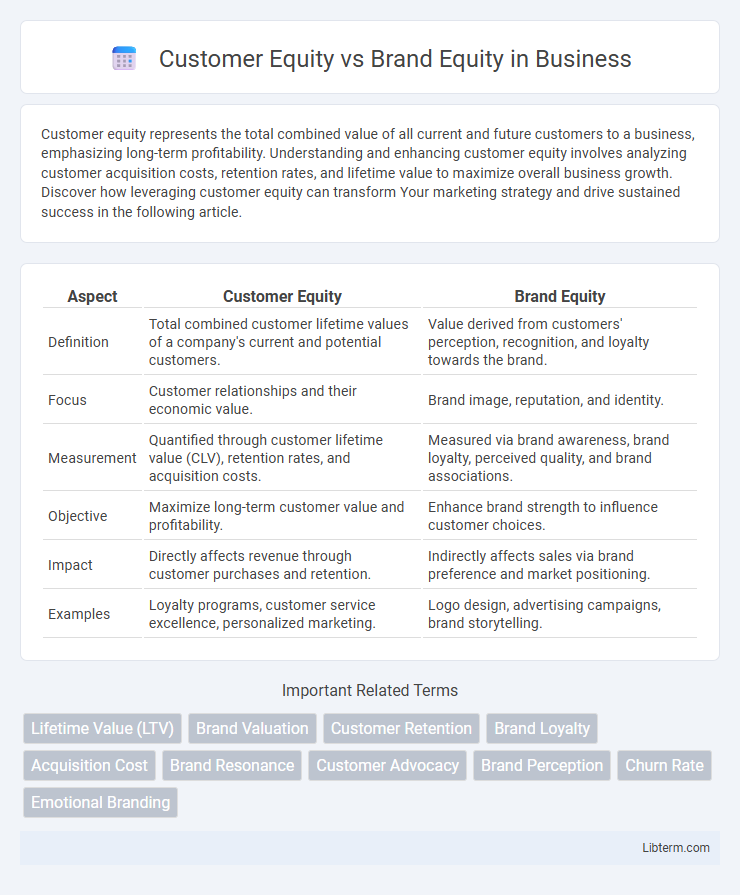Customer equity represents the total combined value of all current and future customers to a business, emphasizing long-term profitability. Understanding and enhancing customer equity involves analyzing customer acquisition costs, retention rates, and lifetime value to maximize overall business growth. Discover how leveraging customer equity can transform Your marketing strategy and drive sustained success in the following article.
Table of Comparison
| Aspect | Customer Equity | Brand Equity |
|---|---|---|
| Definition | Total combined customer lifetime values of a company's current and potential customers. | Value derived from customers' perception, recognition, and loyalty towards the brand. |
| Focus | Customer relationships and their economic value. | Brand image, reputation, and identity. |
| Measurement | Quantified through customer lifetime value (CLV), retention rates, and acquisition costs. | Measured via brand awareness, brand loyalty, perceived quality, and brand associations. |
| Objective | Maximize long-term customer value and profitability. | Enhance brand strength to influence customer choices. |
| Impact | Directly affects revenue through customer purchases and retention. | Indirectly affects sales via brand preference and market positioning. |
| Examples | Loyalty programs, customer service excellence, personalized marketing. | Logo design, advertising campaigns, brand storytelling. |
Understanding Customer Equity and Brand Equity
Customer equity measures the total combined value of all customer relationships a company maintains, emphasizing the long-term profitability and loyalty of its customer base. Brand equity reflects the perceived value and strength of a brand in the marketplace, driven by brand awareness, associations, and customer perceptions. Understanding both concepts is crucial for businesses aiming to optimize marketing strategies that enhance customer lifetime value and brand preference simultaneously.
Key Components of Customer Equity
Customer equity consists of three key components: value equity, which reflects customers' perceptions of the product's quality and price; brand equity, representing the loyalty and attachment customers have towards a brand; and relationship equity, which measures the strength of the ongoing relationship between the customer and company. While brand equity focuses on the intangible value derived from brand recognition and reputation, customer equity emphasizes the total combined value of current and potential customers based on their future purchase behavior. Maximizing customer equity requires enhancing product value, building strong brand loyalty, and fostering long-term customer relationships to drive sustainable business growth.
Essential Elements of Brand Equity
Brand equity primarily revolves around customer perceptions, including brand awareness, brand associations, perceived quality, and brand loyalty, which collectively enhance a brand's value. Customer equity focuses on the total combined customer lifetime values, emphasizing acquisition, retention, and expansion metrics. Essential elements of brand equity such as strong brand awareness, positive brand image, and consistent customer experiences directly influence customer equity by driving long-term profitability and sustained competitive advantage.
How Customer Equity Impacts Business Value
Customer equity directly influences business value by representing the total combined customer lifetime values, which signal future revenue streams and profitability. High customer equity reflects strong customer loyalty, retention, and advocacy, leading to reduced marketing costs and sustainable competitive advantage. This metric allows businesses to prioritize investments in customer relationships, ultimately driving long-term growth and market valuation.
The Role of Brand Equity in Consumer Perception
Brand equity significantly influences consumer perception by shaping the perceived value, quality, and trustworthiness of a brand, which directly impacts customer loyalty and purchase decisions. Strong brand equity creates emotional connections and brand recognition that enhance consumer confidence, often leading to premium pricing and sustained competitive advantage. Unlike customer equity, which measures the total value of customers to a business, brand equity focuses specifically on the intangible brand assets that drive consumer preferences and behavior.
Measuring Customer Equity: Metrics and Methods
Measuring customer equity involves analyzing metrics such as customer lifetime value (CLV), retention rates, and acquisition costs to quantify the total value generated by a company's customer base. Methods include cohort analysis, which tracks the behavior and profitability of specific customer groups over time, and predictive modeling, which forecasts future revenue from current customers using historical purchase data. Accurate measurement of customer equity enables businesses to optimize marketing strategies and allocate resources effectively for maximizing long-term profitability.
Assessing Brand Equity: Tools and Techniques
Assessing brand equity involves tools like brand audits, customer surveys, and financial analysis to measure brand strength and market value. Techniques such as the Brand Asset Valuator (BAV), Net Promoter Score (NPS), and BrandZ rankings provide insights on consumer perceptions, loyalty, and brand performance. These assessments enable companies to quantify brand equity in customer retention, price premium, and competitive advantage.
Customer Equity vs Brand Equity: Key Differences
Customer Equity represents the total combined lifetime value of all customers, emphasizing revenue generated through customer relationships, while Brand Equity reflects the value derived from consumer perception, brand recognition, and loyalty. Customer Equity is driven by acquisition, retention, and customer value metrics, whereas Brand Equity hinges on brand awareness, perceived quality, and brand associations. The key difference lies in Customer Equity's focus on financial impact tied directly to customers, compared to Brand Equity's focus on intangible assets related to brand strength and market positioning.
Strategies to Enhance Both Customer and Brand Equity
Maximizing customer equity requires personalized loyalty programs, targeted customer relationship management (CRM), and continuous value delivery to boost customer lifetime value (CLV). Enhancing brand equity involves consistent brand messaging, emotional brand storytelling, and strategic brand positioning to strengthen brand awareness, perceived quality, and brand associations. Integrating data-driven insights allows companies to tailor strategies that simultaneously elevate customer satisfaction and reinforce brand preference, leading to sustainable competitive advantage.
Balancing Customer Equity and Brand Equity for Business Growth
Balancing customer equity and brand equity is crucial for sustainable business growth, as customer equity emphasizes the lifetime value and loyalty of customers, while brand equity highlights the perceived value and reputation of the brand. Investing in customer relationship management and delivering consistent brand experiences enhances both equities, driving repeat purchases and increasing market share. Businesses that strategically align customer-centric initiatives with strong brand positioning achieve higher profitability and long-term competitive advantage.
Customer Equity Infographic

 libterm.com
libterm.com